End Content Chaos: Find Your Perfect Free Editorial Calendar Template
Juggling blog posts, social media updates, video scripts, and newsletters without a central plan leads to missed deadlines, inconsistent messaging, and team burnout. This is where a well-structured editorial calendar transforms from a simple spreadsheet into the command center for your entire content operation. It’s the strategic document ensuring every piece of content has a purpose, a place, and a publication date. To see these principles in action and get inspired, you can explore various editorial calendar examples that showcase different successful layouts.
Finding the right system, however, can be just as challenging as creating the content. Many solutions are overly complex or carry a hefty price tag. That’s why we’ve curated this definitive list. Here, we will dive deep into 12 of the best options for a free editorial calendar template, from flexible spreadsheets for solo creators to powerful, integrated platforms for growing teams. This guide moves beyond generic feature lists to provide practical insights, helping you select the perfect tool that aligns with your specific workflow, team size, and strategic goals. The result is a more orderly and efficient content creation process.
1. Google Sheets
For teams and individuals who prioritize flexibility and cost-effectiveness, Google Sheets stands out as the ultimate DIY free editorial calendar template. Its power lies in its infinite customizability. Unlike rigid, pre-built software, a spreadsheet allows you to create a system perfectly tailored to your specific workflow, tracking the exact metrics and stages that matter to your content strategy, all without any subscription fees. It's accessible from any device with an internet connection, making real-time collaboration seamless.
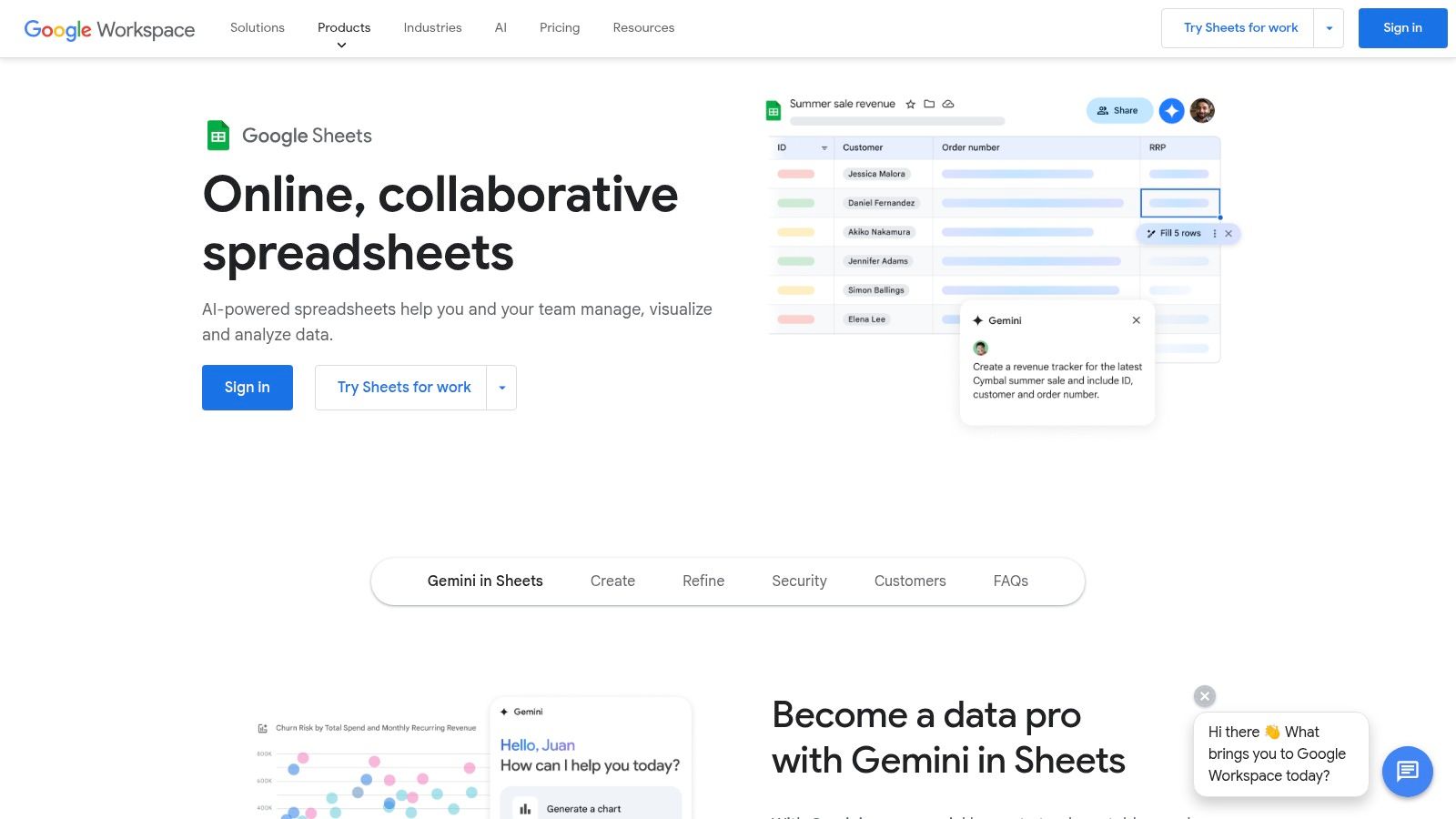
Practical Application & Use Cases
The true value of Google Sheets emerges when you leverage its built-in functions. A digital marketing agency can use conditional formatting to automatically color-code cells based on content status, like "Draft," "In Review," or "Published," providing an at-a-glance overview of the pipeline. Solo creators can implement data validation to create dropdown menus for content types or social media platforms, ensuring consistency. For any team, its real-time collaboration features are essential for leaving feedback directly on content drafts and updating statuses instantly.
Implementation & Limitations
Getting started requires manual setup, as you begin with a blank canvas. To save time, you can build upon a ready-to-use social media calendar template and customize it further. The primary limitation is the lack of direct software integrations and automation. You cannot automatically publish to social platforms or receive sophisticated notifications as you would with dedicated marketing tools.
- Pros: Completely free, highly customizable, excellent for real-time team collaboration.
- Cons: Requires significant initial setup, lacks built-in automation and integrations, can become unwieldy if not well-organized.
Website: https://www.google.com/sheets/about/
2. Trello
For teams that thrive on visual workflow management, Trello offers a dynamic and intuitive free editorial calendar template. Its Kanban-style system of boards, lists, and cards allows you to visualize your entire content pipeline, from the initial idea to final publication. The drag-and-drop interface makes it incredibly simple to track progress and adjust schedules on the fly, providing a clear, high-level overview for the entire team without a steep learning curve.
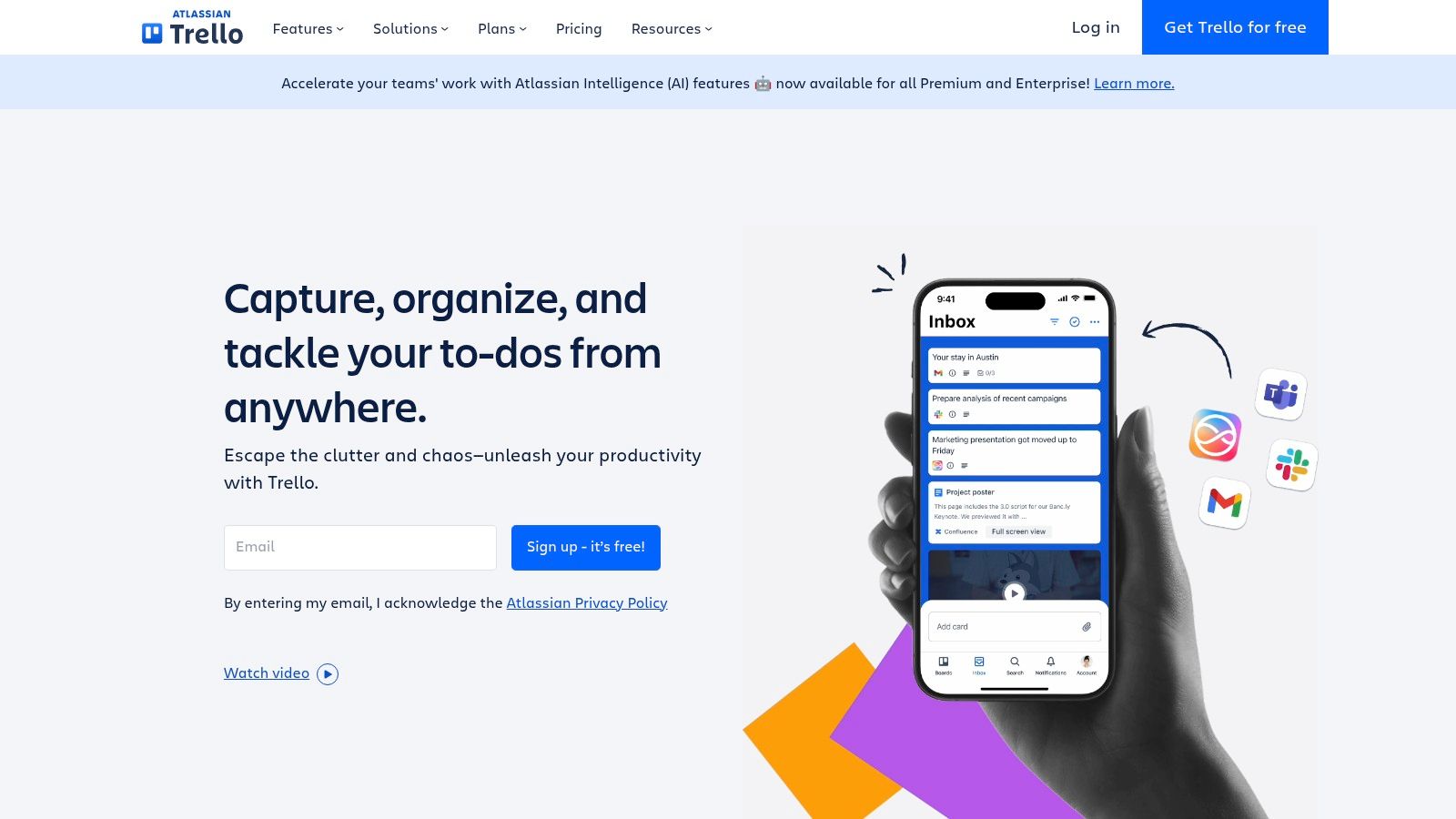
Practical Application & Use Cases
A marketing agency can structure a board with lists representing each stage of content production: "Ideas," "Assigned," "Drafting," "In Review," and "Published." Each content piece becomes a card that moves across the board. These cards can hold checklists for subtasks, due dates, attached drafts, and comments for seamless collaboration. Activating the free "Calendar Power-Up" provides a traditional calendar view, giving managers a clear perspective on upcoming deadlines and potential content gaps.
Implementation & Limitations
Getting started is as simple as creating an account and a new board. You can build from scratch or adapt a public template to fit your needs. While the free tier is generous, its main limitation is the cap on Power-Ups (integrations and added features), which restricts advanced automation. For very large teams managing hundreds of active content pieces, a single board can become cluttered and difficult to navigate without disciplined archiving practices.
- Pros: Highly visual and intuitive, flexible drag-and-drop functionality, strong free version for core needs.
- Cons: Advanced automation and integrations require paid plans, can become visually overwhelming with large project volumes.
Website: https://trello.com/
3. Asana
For teams seeking a more structured environment than a spreadsheet, Asana offers a robust project management framework that doubles as an excellent free editorial calendar template. It transforms content planning from a simple list into an actionable workflow. With views like List, Board (Kanban), and Calendar, teams can visualize their content pipeline in the format that best suits their process. Its core strength is turning strategic goals into trackable tasks, ensuring every piece of content has a clear owner, deadline, and purpose.

Practical Application & Use Cases
A content team can use Asana's Board view to create columns for "Idea," "Drafting," "Review," and "Published." Each content piece is a card that moves across the board as it progresses. Within each card, you can create subtasks for writing, graphic design, and promotion, assigning them to different team members with unique due dates. The Calendar view then provides a high-level look at publish dates, helping managers spot content gaps and avoid scheduling conflicts across campaigns.
Implementation & Limitations
Asana provides ready-to-use project templates, including some for content calendars, which significantly speeds up the setup process. You can start with a template and customize it to your needs. The free plan is quite generous for small teams, but its primary limitation is the lack of advanced features like custom fields, which are crucial for tracking specific metrics like content type or target persona. The sheer number of features can also be overwhelming for individuals or teams looking for a simple scheduling tool.
- Pros: User-friendly interface with robust features, suitable for teams of all sizes, free plan available with essential functionalities.
- Cons: Advanced features and integrations require paid plans, can be overwhelming for new users due to its extensive feature set.
Website: https://asana.com/
4. Notion
Notion offers an all-in-one workspace that doubles as a highly dynamic free editorial calendar template. It integrates project management, databases, and documents, allowing users to build a truly customized content hub. This structure is ideal for teams and individuals who want to manage their entire content lifecycle, from ideation to post-analysis, within a single, interconnected tool.

Practical Application & Use Cases
A marketing team can use a Notion database to track content with multiple views. The Kanban view visually maps out progress from "Idea" to "Published," while the calendar view provides a high-level schedule. Each item on the calendar is a full page where you can write drafts, embed design files, and leave comments, keeping all assets and communication centralized for a specific piece of content.
Implementation & Limitations
You can begin quickly by adapting a pre-built template from Notion's community gallery. The primary limitation is its potential complexity; the sheer number of features can present a steep learning curve for beginners. While the free plan is robust for personal use, advanced permissions and unlimited file uploads are reserved for paid tiers, and it lacks direct publishing automation.
- Pros: Immensely flexible and customizable, serves as an all-in-one workspace, generous free plan.
- Cons: Steeper learning curve than simpler tools, advanced team features require a subscription.
Website: https://www.notion.so/
5. Airtable
Airtable elevates the spreadsheet concept by merging it with a powerful yet accessible database, making it a superior free editorial calendar template for teams needing structure and flexibility. It moves beyond simple rows and columns, allowing you to link records, create different views from the same data, and build a truly relational content engine. This hybrid approach provides a visual, organized, and highly functional platform for managing complex content pipelines without the rigidity of traditional project management software.

Practical Application & Use Cases
The power of Airtable lies in its multiple views. A content marketing team can use the Kanban view to drag-and-drop articles between stages like "Ideation," "Drafting," and "Published." The same data can be instantly switched to a Calendar view to check for content gaps or to a Grid view for a detailed data overview. Its automation features allow you to set up triggers, such as automatically notifying a team member in Slack when a post's status changes to "Ready for Review."
Implementation & Limitations
Getting started is streamlined thanks to a gallery of pre-built templates, including several for content calendars that you can customize. The main limitation of the free plan is the cap on records per base (1,000) and automation runs per month, which can be restrictive for high-volume content teams. While more intuitive than a raw database, users accustomed only to basic spreadsheets may face a slight learning curve to leverage its more advanced relational features effectively.
- Pros: Highly visual and customizable with multiple views, powerful free plan for smaller teams, offers robust integrations and automation.
- Cons: Advanced features and higher limits are locked behind paid plans, can be overly complex for users with very simple tracking needs.
Website: https://airtable.com/
6. CoSchedule
CoSchedule offers a comprehensive marketing calendar that bridges the gap between content planning and social media execution. For teams that have outgrown spreadsheets, its free plan provides an excellent, feature-rich free editorial calendar template. The platform is designed around a unified drag-and-drop calendar, allowing you to visualize your entire marketing strategy, from blog posts to social campaigns, in a single, cohesive view. It’s a significant step up in organization and automation.

Practical Application & Use Cases
A marketing agency can leverage CoSchedule to manage multiple client calendars, assigning tasks and scheduling content directly within the platform. Its direct WordPress integration is a powerful advantage, enabling users to draft, schedule, and publish blog posts without leaving the calendar interface. The built-in social media scheduler allows for creating and automating promotional posts tied to each piece of content, a feature that solidifies its place among the top social media scheduling tools available.
Implementation & Limitations
Getting started with CoSchedule is intuitive, as the interface guides you through connecting your social profiles and blog. The primary limitation lies in its freemium model. The free calendar is excellent for organization and basic scheduling, but powerful features like social analytics, ReQueue for evergreen content, and advanced team collaboration are locked behind paid subscriptions. These costs can become a considerable factor for smaller operations or solo creators.
- Pros: Comprehensive tool for content and social media management, user-friendly interface with powerful features, free plan available with essential functionalities.
- Cons: Advanced features require paid plans, can be expensive for small teams.
Website: https://coschedule.com/
7. Monday.com
Monday.com positions itself as a "Work OS," a powerful project management platform that excels when configured as a free editorial calendar template. Its strength is blending robust project tracking with a visually intuitive interface. Teams can build highly specific content pipelines from scratch or adapt a pre-built template, managing every stage from ideation to publication within a single, collaborative workspace. The platform's flexibility allows it to serve small teams and solo creators with its generous free plan.
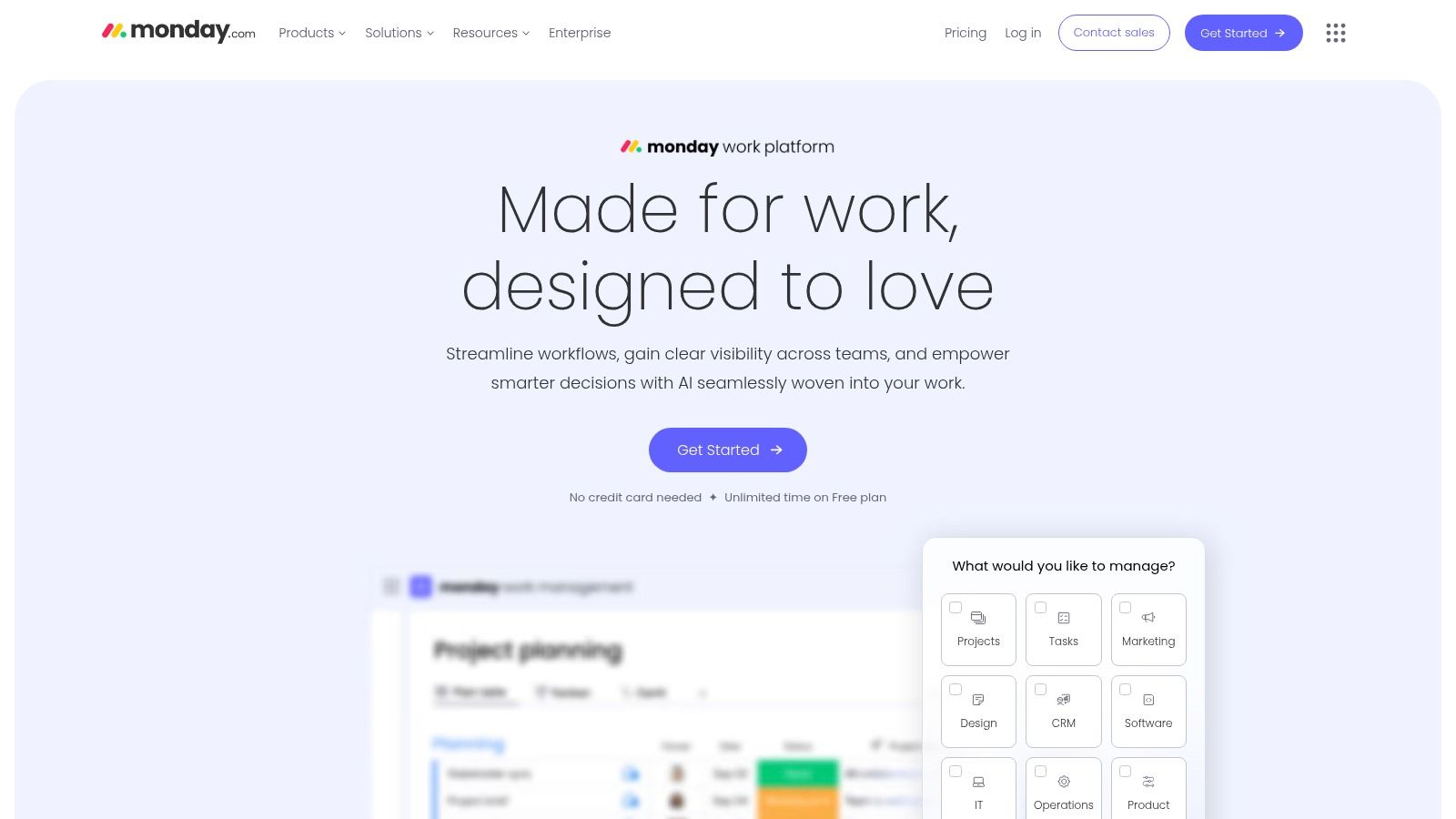
Practical Application & Use Cases
A content marketing team can leverage Monday.com’s different views for total pipeline clarity. They might use a Kanban board to drag-and-drop articles through stages like "Pitch," "Writing," "Editing," and "Scheduled." Simultaneously, the Calendar view provides a high-level look at publication dates, preventing content clashes. Using automation recipes, a manager can set a rule to automatically notify the social media manager once a blog post’s status changes to "Published," streamlining the promotion process without manual intervention.
Implementation & Limitations
Getting started is user-friendly, as you can select a content calendar template during setup. However, the sheer volume of features and customization options can be overwhelming for new users. The primary limitation of the free plan is its cap on users (up to 2 seats) and the number of automations you can run per month. While functional for individuals or pairs, growing teams will quickly need to upgrade to a paid plan to access more advanced integrations, views, and unlimited automations.
- Pros: Highly customizable with multiple views, user-friendly interface, and a functional free plan for small teams.
- Cons: Advanced features and scale require paid plans, can be feature-heavy and overwhelming for beginners.
Website: https://monday.com/
8. ClickUp
For teams that have outgrown spreadsheets and need a powerful, all-in-one productivity hub, ClickUp offers a remarkably robust free editorial calendar template. It’s more than just a calendar; it's a complete project management environment designed to handle complex content workflows from ideation to publication. Its strength lies in consolidating tasks, documents, and communication into a single, customizable space, making it ideal for content teams that require deep operational control and visibility over their entire pipeline.
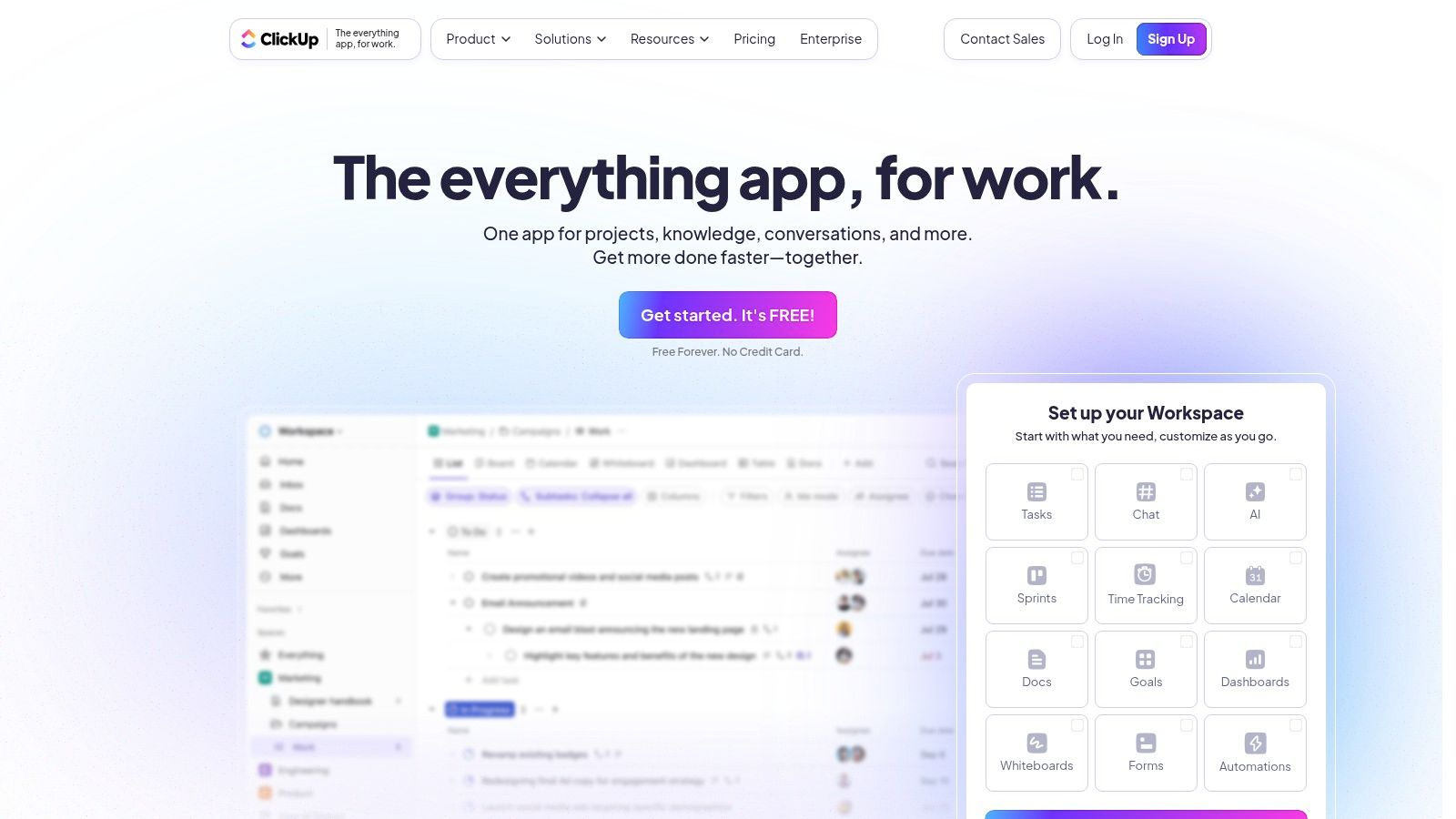
Practical Application & Use Cases
A digital marketing agency can use ClickUp to manage multiple client calendars simultaneously, using different "Spaces" for each. Within a space, the Calendar View provides a high-level look at publishing dates, while the Board View visualizes the content pipeline with custom statuses like "Brief Created," "First Draft," and "Client Approval." Tasks can be assigned to writers, designers, and editors with specific subtasks and deadlines, ensuring every step is tracked and accounted for.
Implementation & Limitations
Getting started is simplified by using one of ClickUp's pre-made content calendar templates, which you can then customize. The primary challenge is the platform's sheer depth; the vast number of features can present a steep learning curve for new users or small teams seeking a simple tool. While its free plan is one of the most generous available, critical features for scaling teams, like advanced reporting and unlimited automations, are reserved for paid subscriptions.
- Pros: User-friendly interface with robust features, suitable for teams of all sizes, free plan available with essential functionalities.
- Cons: Advanced features require paid plans, can be overwhelming for new users.
Website: https://clickup.com/
9. HubSpot
For marketers seeking a solution that goes beyond a simple spreadsheet, HubSpot offers a powerful free editorial calendar template deeply integrated into its marketing platform. This isn't just a planning tool; it's a command center that connects your content strategy directly to execution, including email marketing, landing pages, and CRM activities. It is designed for those who want to track the entire content lifecycle from idea to lead generation, providing a holistic view of content performance within a single ecosystem.
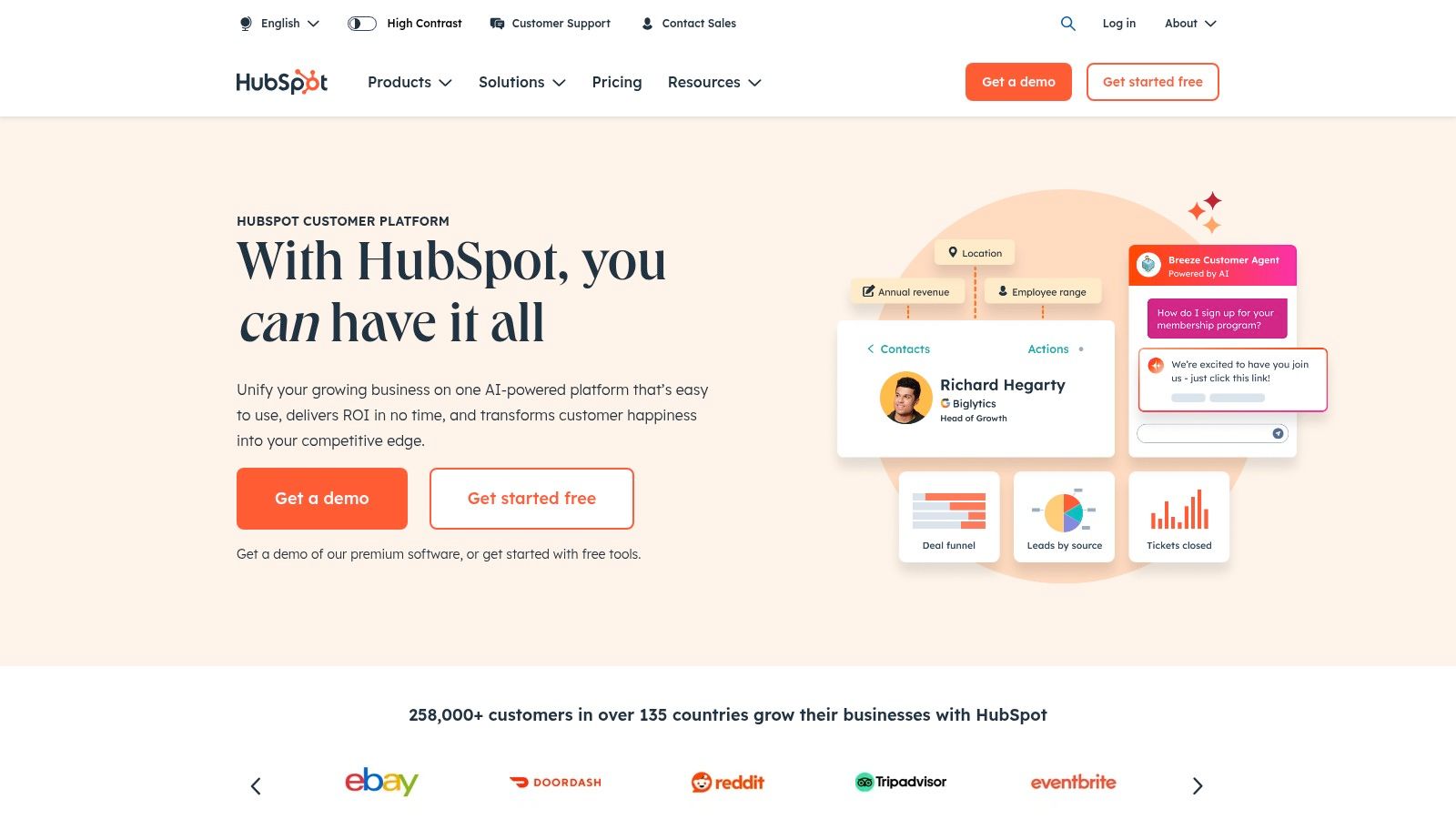
Practical Application & Use Cases
A small business team can use HubSpot's calendar to map out a multi-channel campaign, ensuring a new blog post is supported by coordinated social media updates and a targeted email newsletter. Because the calendar is tied to the HubSpot CRM, you can directly associate content assets with specific marketing campaigns and track their influence on lead conversion. This allows you to answer critical questions, like which blog topics are most effective at moving prospects through the sales funnel, providing invaluable data for future planning.
Implementation & Limitations
To access the calendar, you need to sign up for a free HubSpot account. While the interface is clean, its true value is realized by adopting the wider HubSpot suite, which can involve a significant learning curve. The main limitation is the paywall; advanced reporting, marketing automation, and SEO tools are reserved for paid subscribers. While it includes basic social media functions, teams with heavy scheduling needs may find they require more specialized crossposting solutions for better efficiency.
- Pros: Comprehensive tool integrated with CRM, free with a HubSpot account, excellent for connecting content to marketing results.
- Cons: Can be complex for new users, most advanced features require paid plans, works best within the HubSpot ecosystem.
Website: https://www.hubspot.com/
10. Loomly
Loomly positions itself as a comprehensive brand success platform, moving beyond a simple calendar to offer a full suite of tools for social media management. While not a permanently free tool, its 15-day trial provides a robust opportunity to test-drive a professional system. It serves as an excellent temporary free editorial calendar template for teams wanting to experience an all-in-one solution that connects planning, creation, publishing, and analytics in a single, collaborative environment.
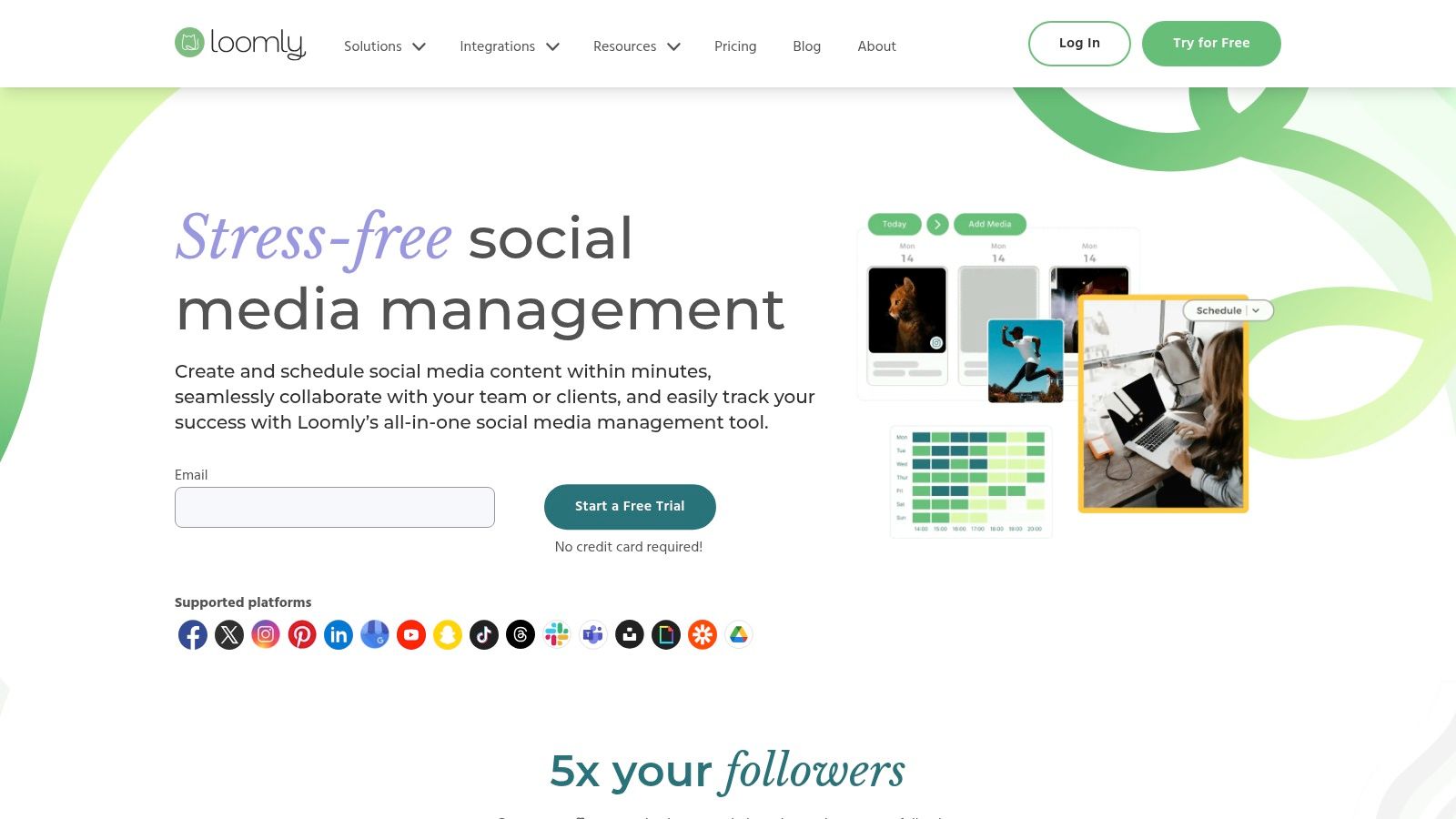
Practical Application & Use Cases
Loomly excels in team-based workflows where content requires multiple approval stages. A marketing agency can use it to create post mockups, get real-time optimization tips, and then seamlessly pass the draft to a client for review and approval, all within the platform. For in-house teams, its calendar provides automated publishing and post ideas based on trending topics, holidays, and social media best practices, saving significant research time and ensuring a consistent content pipeline.
Implementation & Limitations
Implementation is user-friendly, with a guided setup during the trial period. The primary limitation is its business model; it is a premium tool, and access is lost after the 15-day trial without a paid subscription. This makes it unsuitable for those seeking a permanent free solution. Additionally, the most powerful features, such as advanced analytics and custom workflows, are locked behind higher-priced plans, making the entry-level tier feel somewhat basic for power users.
- Pros: User-friendly interface with intuitive navigation, Comprehensive tool for content management, Suitable for teams of all sizes.
- Cons: No free plan; only a 15-day free trial, Advanced features require higher-tier plans.
Website: https://www.loomly.com/
11. Evernote
While known as a note-taking giant, Evernote's powerful organizational features make it a surprisingly effective free editorial calendar template for content creators and small teams. It excels at centralizing the entire content lifecycle, from initial brainstorming and research to final draft storage. By using its flexible structure of notebooks and tags, you can transform a simple note app into a dynamic content planning system, keeping all related assets and ideas neatly organized in one place.

Practical Application & Use Cases
A freelance writer can create a dedicated "Editorial Calendar" notebook, with each note representing a single content piece. Within each note, they can use checklists to track workflow stages like "Outline," "Draft," and "Submit," while using tags to categorize by client, status ("In Progress," "Completed"), or publication date. Small marketing teams can utilize shared notebooks to collaborate on campaign ideas, allowing members to clip web articles for research, add meeting notes, and draft copy in a unified workspace.
Implementation & Limitations
Getting started is as simple as creating a new notebook and using a note for each content item. You can leverage Evernote's own template gallery to find a calendar or project plan to adapt. The main limitation is that it isn't a true project management tool; it lacks automated workflows, advanced notifications, and the visual timeline capabilities of dedicated software. Furthermore, the free version has constraints on monthly uploads and the number of devices you can sync.
- Pros: User-friendly interface with robust features, Suitable for individuals and small teams, Free plan available with essential functionalities.
- Cons: Advanced features require paid plans, Limited project management capabilities.
Website: https://evernote.com/
12. WordPress Editorial Calendar Plugin
For content creators and businesses whose strategy is centered around their blog, the WordPress Editorial Calendar plugin is an indispensable tool. It transforms the standard post list into a visual, interactive calendar directly within the WordPress dashboard. This plugin serves as a highly effective free editorial calendar template by integrating planning and execution into the same environment, streamlining the entire blog management process for ultimate convenience and efficiency.
Practical Application & Use Cases
The plugin's drag-and-drop interface is its standout feature. A multi-author blog manager can easily see content gaps and reschedule posts by simply moving them to a new date on the calendar. For solo bloggers, it provides a clear overview of their publishing consistency. You can also manage drafts directly from the calendar view, quickly editing titles, content status, or publication times without navigating to the main posts screen, which significantly speeds up the workflow for high-volume content schedules.
Implementation & Limitations
Implementation is straightforward: install and activate the plugin directly from the WordPress plugin repository. However, its primary limitation is its scope. The calendar is exclusively for managing WordPress posts and pages; it does not extend to social media campaigns or other marketing channels. It is a specialized tool for on-site content, not a comprehensive marketing hub for a multi-channel strategy.
- Pros: Deeply integrated with WordPress, completely free, intuitive drag-and-drop scheduling.
- Cons: Limited to managing WordPress content only, lacks features for broader marketing campaigns.
Website: https://wordpress.org/plugins/editorial-calendar/
Editorial Calendar Tools Feature Comparison
| Platform | Core Features/Characteristics | User Experience/Quality ★ | Value Proposition 💰 | Target Audience 👥 | Unique Selling Points ✨ |
|---|---|---|---|---|---|
| Google Sheets | Collaborative spreadsheets, customizable templates | ★★★☆☆ User-friendly, flexible | 💰 Free with Google account | Individuals, teams | Familiar interface, real-time collaboration |
| Trello | Boards, lists, cards, drag-and-drop task management | ★★★☆☆ Intuitive, visual | 💰 Free version; paid for advanced features | Small to medium teams | Visual task organization, calendar view |
| Asana | Multiple project views, task assignments, reporting | ★★★★☆ Robust and user-friendly | 💰 Free plan; paid for advanced integrations | Teams of all sizes | Versatile project tracking and analytics |
| Notion | All-in-one workspace, rich media, multiple views | ★★★★☆ Highly customizable | 💰 Free plan; paid for advanced features | Individuals & teams | Flexible databases and rich media support |
| Airtable | Spreadsheet-database hybrid, automations, multiple views | ★★★★☆ Powerful, customizable | 💰 Free plan; paid for advanced features | Teams needing database features | Automations and extensive integrations |
| CoSchedule | Drag-and-drop calendar, social scheduling & automation | ★★★★☆ User-friendly, comprehensive | 💰 Paid plans; free trial available | Marketing teams & agencies | Social automation, WordPress integration |
| Monday.com | Custom workflows, multiple views, automation | ★★★★☆ Robust, customizable | 💰 Free plan; paid for advanced features | Teams with complex workflows | Extensive automation and views |
| ClickUp | Custom workflows, multiple views, task tracking | ★★★★☆ Feature-rich, scalable | 💰 Free plan; paid for advanced features | Small to large teams | Detailed reporting and task management |
| HubSpot | Editorial calendar integrated with marketing tools | ★★★★☆ User-friendly with analytics | 💰 Free with account; paid for full tools | Marketing teams, enterprises | Marketing suite integration and reporting |
| Loomly | Content calendar, post ideas, direct social publishing | ★★★★☆ Intuitive, marketing-focused | 💰 No free plan; 15-day trial | Marketing teams, brands | Post optimization tips, direct publishing |
| Evernote | Note-taking, tagging, organizational templates | ★★★☆☆ User-friendly but limited PM | 💰 Free plan; paid for advanced features | Individuals, small teams | Note organization with collaboration |
| WordPress Editorial Calendar | Drag-and-drop scheduling inside WordPress dashboard | ★★★☆☆ Simple, integrated | 💰 Free with WordPress | WordPress users, bloggers | Native WordPress integration |
From Planning to Performance: Activating Your Content Calendar
We've journeyed through a comprehensive landscape of 12 distinct tools, each offering a unique approach to organizing your content strategy. From the universal accessibility of Google Sheets to the robust project management power of Asana and ClickUp, it’s clear that a one-size-fits-all solution doesn't exist. The perfect free editorial calendar template for your operation is the one that seamlessly integrates into your existing workflow and empowers, rather than encumbers, your team.
The core takeaway is this: your calendar is more than a schedule; it's your strategic command center. It provides the structure necessary to transform chaotic brainstorming sessions into a cohesive, goal-driven content plan. The right template gives you clarity, fosters collaboration, and ensures a consistent presence, which is the foundation of building an engaged audience.
How to Select Your Ideal Starting Point
Choosing the right tool can feel overwhelming, but you can simplify the decision by focusing on your team’s structure and primary needs. Your goal is to find the path of least resistance to consistent usage.
- For Solo Creators and Small Startups: Simplicity is key. A customized Google Sheets template, a visual Trello board, or a flexible Notion workspace often provides the perfect balance of structure and freedom without a steep learning curve.
- For Growing Marketing Teams and Agencies: Collaboration and process management become critical. Look towards Asana, Monday.com, or ClickUp. Their free tiers offer advanced features like task dependencies, multiple views (Kanban, calendar, list), and clear assignment tracking to manage complex, multi-stage content pipelines.
- For Brands Invested in an Ecosystem: If your team already operates within a specific software suite, leverage its native tools. The HubSpot calendar is an excellent choice for those using its CRM, while the WordPress Editorial Calendar Plugin is a no-brainer for content teams living inside the WordPress dashboard.
Beyond the Template: Keys to Successful Implementation
Simply downloading a template is not the final step; it’s the first. True success lies in how you activate it within your organization. A beautiful, empty calendar achieves nothing. To make it a living document, you must focus on implementation.
First, secure team buy-in by involving everyone in the selection and setup process. When your team feels ownership, they are far more likely to adopt the tool. Second, establish clear and simple workflows. Define who is responsible for each stage of the content lifecycle: ideation, drafting, approval, design, scheduling, and analysis.
Finally, think about integration and efficiency. A static calendar is good for planning, but modern content production requires automation to save time and reduce manual errors. To further streamline these processes, many teams are exploring how the latest AI Content Creation Tools can help automate research, drafting, and even scheduling, freeing up creators to focus on high-level strategy. This transforms your calendar from a simple organizational document into a dynamic operational hub.
Your chosen free editorial calendar template is the blueprint for your success. It organizes your vision and aligns your team. By selecting the right framework and committing to a clear workflow, you build the foundation for a powerful and predictable content engine that drives measurable growth.
Now that your content strategy is planned and organized, it's time to put it into action. PostSyncer bridges the gap between your calendar and your audience, automating the scheduling and publishing process across all your channels. Start using PostSyncer today to turn your well-laid plans into consistent, impactful results.















